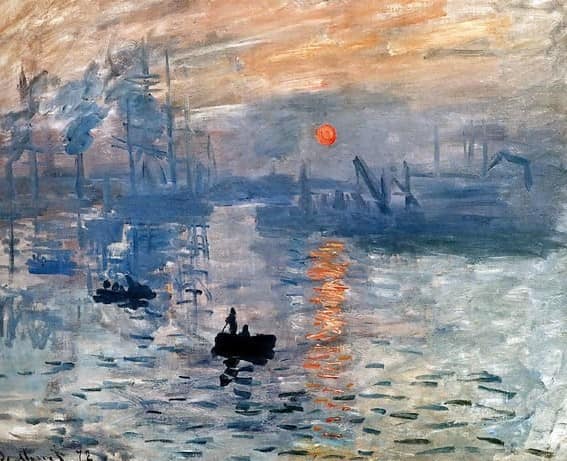No art lesson is complete without a reference to one of the greatest painters, Claude Monet. Here are some useful tips for your next art class.
Oscar-Claude Monet (1840 – 1926) was a famous French painter born in Paris. He is most famous for being the creator of the Impressionist style of painting who has also been credited as one of the essential artists in igniting the modern art movement.
His philosophy and expression of art mainly focused on landscape paintings and the beauty of nature. Monet’s motivation to capture this countryside beauty led to him re-painting the same scenery repeatedly to capture the passage of light over time and the passing of the seasons.
Through this methodical and repetitious practice, Monet would obtain the ability to depict an image that lay before his eyes masterly. This ability would produce some of the finest and most detailed paintings ever created. His paintings are littered with such color, precision, and emotion, that they must be seen to be believed.
The Initiator of Impressionism
Claude Monet achieved his fame and success by being the inventor and leader of a style of painting that would soon become known as Impressionism. Monet’s particular type of impressionism focused mainly on nature with its relation to how he saw it in that precise moment.
Impressionist painters would accurately represent the ever-changing qualities of light, combined with a perception of movement as the primary focus of their work, for they believed that this ‘moving’ was a crucial part of the human experience.
This is perhaps the most interesting aspect of impressionism. To paint in such a way as to try to capture the movement of time rather than a particular moment in time was truly profound and utterly groundbreaking.
Rules Are Made to be Broken
When Impressionism came onto the scene, it was like nothing ever seen before and broke almost all the rules of academic painting. Instead of following lines and contours, they used free-spirited brush strokes and took to scenes of modern life in motion instead of still life compositions.
Furthermore, Impressionist painters took to the outdoors to get a hands-on and intimate feel for the scenery they depicted. Whereas in the previous model, painters usually painted their portraits and landscapes from the comfort of a studio.
Impressionists portrayed visual effects instead of details, movements instead of moments, and perhaps most impressive and incredible, aimed to capture the ultimate beauty of color in the total intensity possible.
As Real as it Gets
Impressionist painters, among other things, created entirely new techniques specific to the style. Among these techniques was an added intensity of color accompanied by an innovative layer of realism. This, along with the immediacy of movement, resulted in a new way of ‘seeing’ to otherwise unspectacular, everyday subject matter.
Also, by focusing on scenes of daily life in motion, impressionists could wonderfully capture the philosophical idea of ‘but a moment in time. They also succeeded in depicting human life in such a way as to embody humanity and our place in nature truly.
Claude Monet, in particular, was an absolute master of these techniques. Outstanding Claude Monet artworks like “Woman in the Garden” and “Garden at Sainte-Adresse” are some examples of Monet’s acute ability to depict scenes that seem, on some level, seem more real than real and indeed come alive on the canvas.
The Color of Light
Another element critical to Impressionism was understanding the effects of light and color and the relationship between the two. Monet was fascinated with light products, which gave his artwork an almost dream-like quality.
Monet made light the main character of his paintings. He wished nothing more than to express how light alters color and our perceptions of reality. His free-flowing style and impeccable use of colors have been described as “mind-blowing,” It is easy to see why many began to adopt his style.
He thought in terms of colors instead of shapes, effects instead of causes, and in terms of shadows and reflections, rather than that of the objects that produced them. This perspective granted his work a level of atmosphere like no other.
Monet’s unique portrayal of landscapes and the movement therein show a level of dedication and expression that is unmatched even today. Moreover, he rejected academic teachings, thus freeing himself from the limits of thought and transcending art itself.
Impression, Sunrise
To look for an example of Monet’s expertise, you need to look no further than his most famous work entitled “Impression Soleil Levant” or “Impression, Sunrise.” For it is by this title alone, the entire style of impressionism derived its name, and there is no more exemplary example of its principles than this.
The painting itself depicts a scene of the port of Le Havre at sunrise. Two rowboats drift along in the foreground as the red sun rises. The dreamy scene embodies everything Monet stood for, and the emotion that comes from the canvas is astounding.
Although the painting is not a realistic view of the harbor that inspired it, it still manages to produce deep emotion from the viewer. Monet managed to perfectly capture the moment of the sunrise. However, he also captured the more profound “feeling” of what looking at such a view inspires.
The Bottom Line
Oscar-Claude Monet will go down in history as one of its finest and most innovative painters. His unique views on art, alongside his theories of movement, color, and the human experience, seem to call our humanity and souls on a deep intuitive level. Yet, above all else, his art speaks to our hearts rather than our minds, and this might be his most significant achievement of all.




